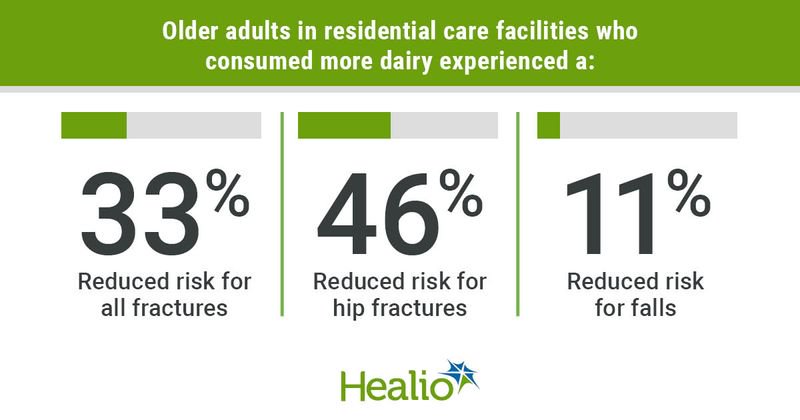Increasing dairy intake reduces risk for falls, fractures in older adults
Increasing calcium and protein intake through dairy products reduced the risk for falls and fractures among older adults living in care homes by 33%, according to results of a randomized controlled trial published in the BMJ.
“Few studies have investigated the efficacy and safety of a nutritional approach to reduction of fracture risk in aged care residents,” Sandra Iuliano, PhD, of the departments of medicine and endocrinology at the University of Melbourne, and colleagues wrote.

Iuliano and colleagues led a 2-year cluster randomized controlled trial in residential care facilities in Australia. Twenty-seven facilities were randomized to provide residents with greater amounts of milk, yogurt and cheese that contained 562 mg of calcium and 12 g of protein for a total daily intake of 1,142 mg of calcium and 69 g of protein. An additional 29 facilities were included as controls, with residents consuming an average of 700 mg per day of calcium and 58 g per day of protein.
Residents in the treatment group were served dairy products in accordance with the Australian Dietary Guidelines, which excluded butter, cream and ice cream, according to the researchers. Lactose-intolerant individuals were given lactose-free options.
Overall, 7,195 residents were enrolled in the study between December 2013 and August 2016. The mean age of residents was 86.7 years in the intervention group and 86.4 years in the control group.
At baseline, the researchers reported that both cohorts were similar in their repletion of vitamin D. Initial calcium and protein intakes were 689 mg and 57 g per day, on average.
During the study, residents in the intervention cohort consumed 3.5 servings of dairy per day, while residents in the control group consumed fewer than 2 servings per day, on average. Over the course of 90,557 person-months of follow up, the researchers identified 324 fractures, which occurred among 3.7% of residents in the intervention group and 5.2% of residents in the control group. This amounted to an estimated 33% reduced risk for fracture with increased dairy intake (95% CI, 0.48-0.93).
The incidence of hip fracture was 1.3% in the intervention group and 2.4% in the control group, yielding a 46% reduced risk for hip fracture (95% CI, 0.35-0.83), according to Iuliano and colleagues. They also reported a 1.8% between-group difference in spine bone mineral density, which the researchers said was due to a 2.1% increase in the intervention group.
The cumulative risk for falls was 57% in the intervention group and 62% in the control group, resulting in an 11% risk reduction (95% CI, 0.78-0.98), the researchers wrote. The risk reductions for falls and fractures were observed by 3 and 5 months, they added.
Individuals in the intervention group had no weight change “in absolute terms,” while those in the control group experienced a mean weight loss of 1.4 kg, Iuliano and colleagues reported. Moreover, there was no difference in all-cause mortality between the groups.
“This nutritional intervention has widespread implications as a public health measure for fracture prevention in the aged care setting and potentially in the wider community,” Iuliano and colleagues wrote.
References:
Iuliano S, et al. BMJ. 2021;doi:10.1136/bmj.n2364.
Increasing dairy intake reduces falls and fractures among older care home residents. https://www.eurekalert.org/news-releases/931878. Published Oct. 20, 2021. Accessed Oct. 21, 2021.
